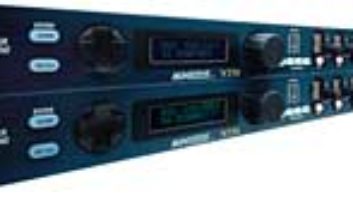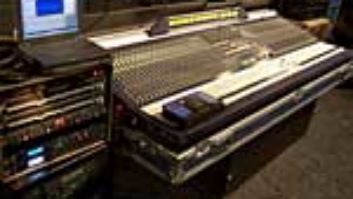BSS introduced the DSP-based Omnidrive Loudspeaker Management System in 1994, and has since developed a comprehensive family of Omnidrive products, all designed to provide multiband crossover, limiting, EQ and delay functions, all in one integrated package. Last year, BSS introduced the affordable Minidrive™, which includes many of the features of BSS’s FDS-355 Omnidrive Compact and FDS-366 Omnidrive Compact Plus units. Functions provided by the Minidrive include a full menu of crossover slopes (up to 48 dB/octave), mid-band limiters, parametric equalization, and up to 635 ms of delay, in 21ms (3/10-inch) steps.
In order to achieve a lower price point, BSS has eliminated some advanced Omni-drive features from the Minidrive. For example, the Minidrive offers a smaller text-only display than the Compact and loses that unit’s third input (though one of the two Minidrive models gains a sixth output). Features found on the Compact Plus but not available on the Minidrive include 96kHz sampling, dynamic EQ filters and an AES digital input. However, the Minidrive’s specs — which include a dynamic range of over 108 dB and distortion under 0.01% — match those of the FDS-355 Compact.
I checked out the FDS-336 Minidrive with six outputs ($1,500 list), but the Minidrive is also available with four outputs as the FDS-334 ($1,250 list). The FDS-336 is aimed toward FOH drive racks, while the FDS-334 provides affordable, stereo, bi-amp mixes for monitor racks.
The FDS-336 has an innovative 3-channel bi-amp configuration that allows an LCR configuration to be created from a stereo mix by summing L and R to create a center channel. Other applications include processing for mono/four/five/six-way systems, and unused outputs in mono mode can be driven by the second input, providing a second chain for driving subwoofer, downfill or frontfill systems. One Minidrive unit can also function as a MIDI master, controlling changes on a second unit via MIDI for two-machine stereo systems.
Some 38 bands of filtering are available in the Minidrive (the Compact offers 60 filters). Crossovers count as two filters per 12 or 24dB/octave “edge,” so a stereo three-way, 24dB crossover with a highpass filter leaves 18 filters for parametric EQ. The 48dB/octave crossover filters eat up processing twice as fast.
Individual outputs can also be run full range, which means that the Minidrive is also well suited for use as a multizone distributed system controller. In this application, the Minidrive could be configured with nine stereo filters on the first two outputs (stereo mains), leaving four filters plus highpass filters available for each of the other four outputs.
Fast-access editing makes the Minidrive convenient to set up and tweak. The four-direction “Navipad” control works just like the one on the Compact Plus: up/down buttons dig through each menu, and left/right keystrokes adjust parameters. The Minidrive also retains the Omnidrive’s familiar rotary encoder for parameter adjustment; one simply steps through channels by pressing on it.
The new push-to-select action on the output knobs provides instant access to any output channel for editing, without having to scroll through them sequentially. These knobs can add or subtract up to 6 dB and have a 0dB center detent, plus there are individual output mutes. Illuminating buttons select either input channel or their sum, allowing access to their menus. The buttons for these, the Utilities menu and the six red output mutes are made of a soft silicone material, which provides a comfortable feel and makes the buttons easy to get around on quickly.
Gone is the graphical representation of output bands found on the Compact’s tiny screen, which never worked as well as on the original, larger Omnidrive screens, but the bright blue, two-line by 16-character LCD screen is easy on the eyes in all light conditions.
Unlike Omnidrive, Minidrive has no PCMCIA card slot for storing additional presets. The Minidrive does offer 60 onboard user program locations, but it is not controllable from SoundBench. Instead, BSS provides MiniStore, a straightforward librarian application that doesn’t edit parameters, but simply dumps to and from a PC computer, re-orders presets and provides offline storage. MiniStore can be downloaded for free from the BSS Website at www.bss.co.uk. Another alternative to SoundBench is the latest version of SIA Software’s Smaart Live analysis program (Version 4.6) that can be used to control the Minidrive via a 9-pin, D-type, “null modem” cable.
Minidrive puts the familiar comfort of OEM and the owner security features of previous Omnidrive products in a flexible, yet affordable package. Users with simpler needs who don’t require the expanded features — such as the third input, dynamic filters, large display and increased preset storage — will find Minidrive’s low pricing very attractive.
BSS Audio, 1449 Donelson Pike, Nashville, TN 37217; 615/360-0277; www.bss.co.uk.
Mark Frink’s is Mix‘s itinerant sound reinforcement editor who this month is at the Super Dome.



